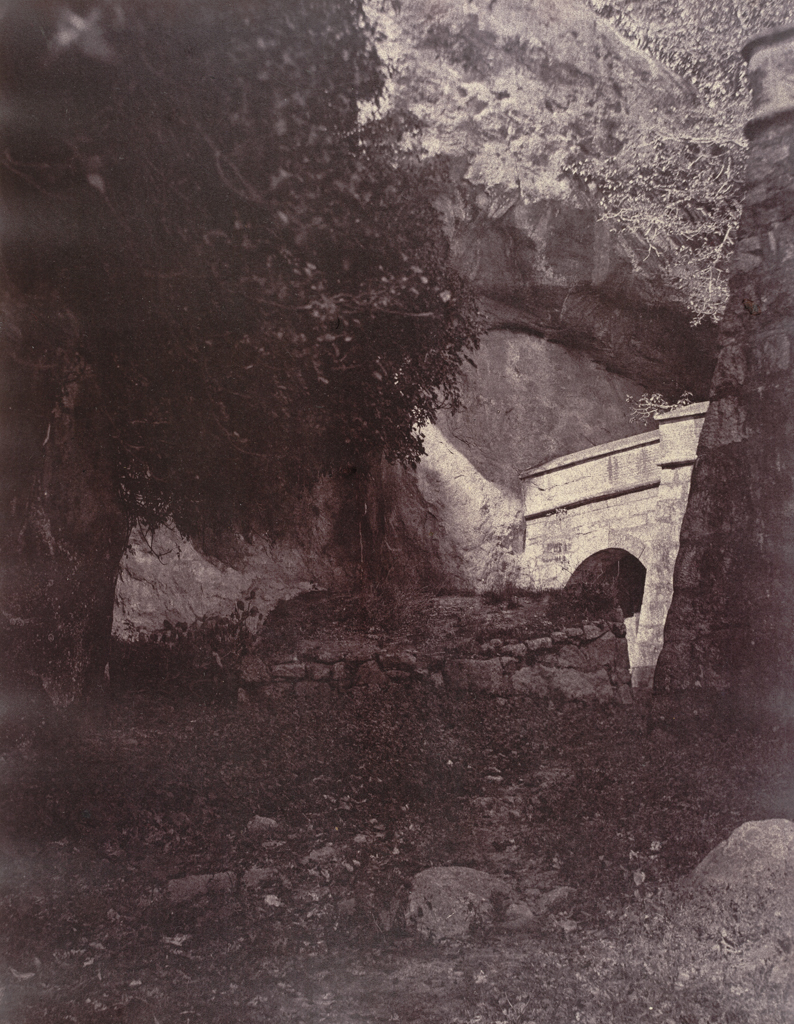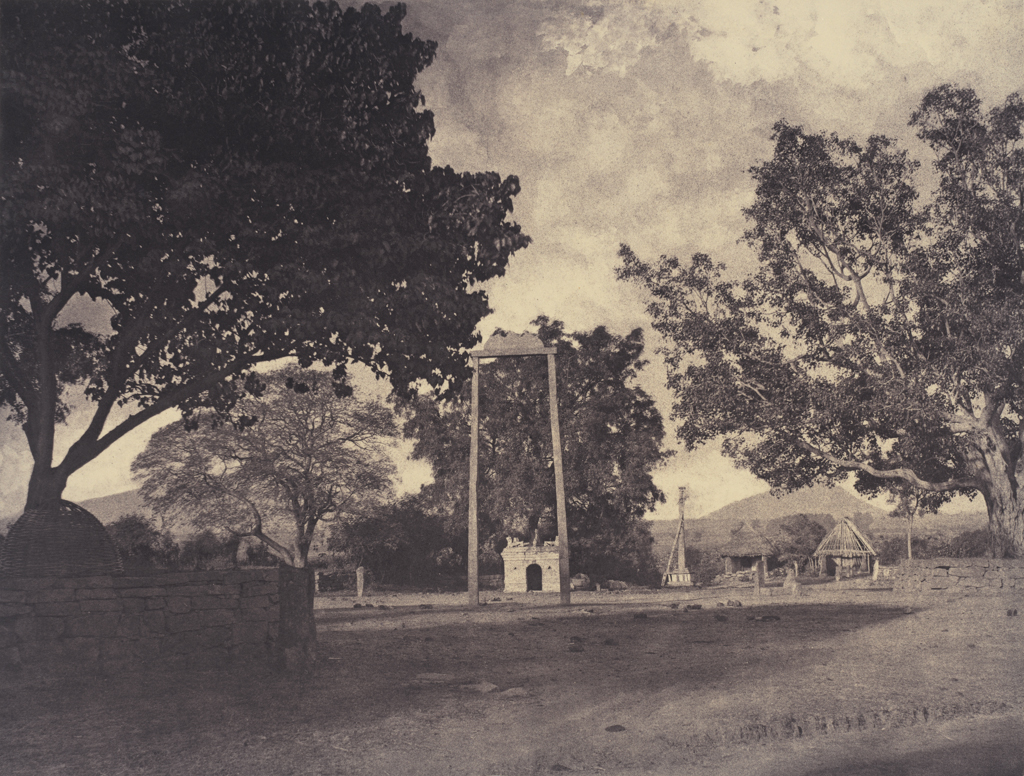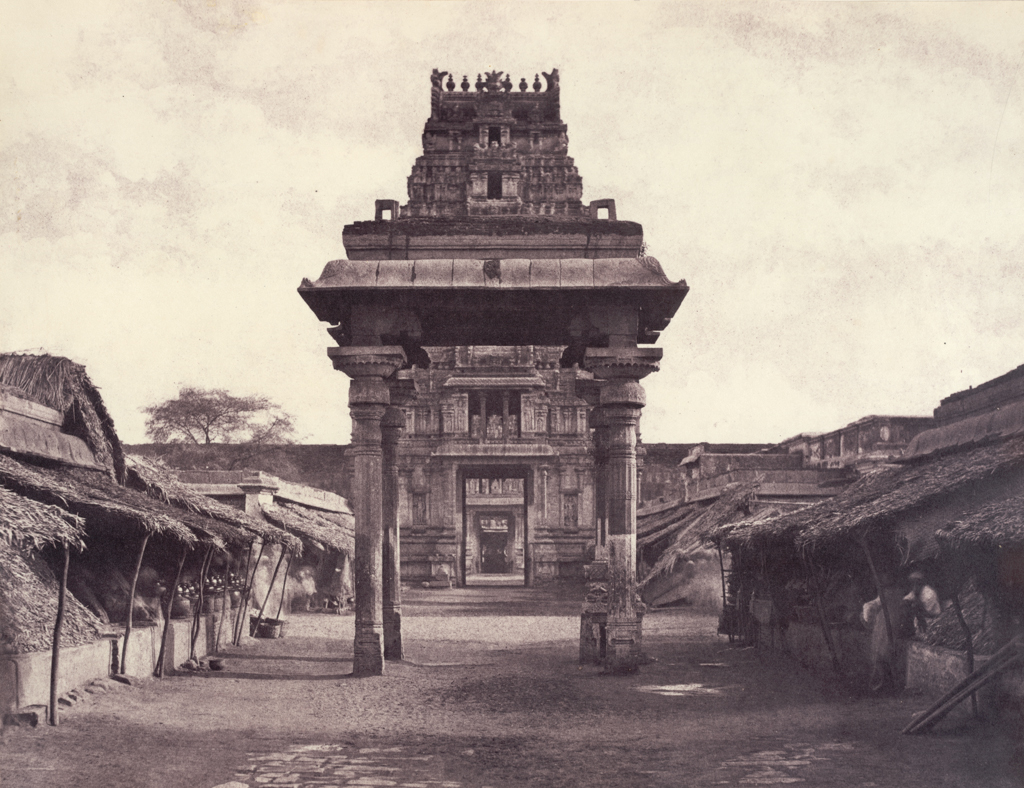South India

Royacottah: Eedgah and Tomb, December 1857–January 1858
Private Collection, Washington, DC
In the 19th century, many British thought that southern India was predominantly Hindu, but this picture of two Islamic religious buildings below the hill fort at Royacottah is evidence of the significant Muslim population there.

Royacottah: View Overlooking the Country, South-Southeast from inside the Fort Gate, December 1857–January 1858
Victoria and Albert Museum, London, Given by Lady Denison
This photograph was made at the base of the hill fort at Royacottah, looking down a wall toward the gate; the fort is situated on top of the adjacent massive rock formation at right. After fierce fighting in 1791, the British captured this hill fort, which rose 900 feet above the plain and commanded a major pass. Tripe photographed it 50 years later when the fort, once considered impregnable, had been abandoned and overgrown.

Royacottah: Gate of the Hill Fort, December 1857–January 1858
The British Library, London
Tripe used a theatrical narrow band of light to illuminate the only passageway into the fort. In the text that accompanies this picture in Tripe’s portfolio, J.A.C. Boswell, an official of the East India Company, reflected on the fierce battles waged here and told of “troubled spirits ... nightly heard wailing around the rock.”

Royacottah: View from the Top of the Hill, Looking North — Northwest and by North, December 1857–January 1858
Collection of Charles Isaacs and Carol Nigro

Beekinpully: Permaul’s Swing at Mariammah Covil, December 1857–January 1858, waxed-paper negative
The Royal Photographic Society Collection at the National Media Museum, Bradford
Comparing this negative with its positive print (next slide) shows that Tripe’s retouching techniques allowed him to create a very different picture from the one recorded by his camera. To compensate for the overexposed foliage, he dabbed the negative with pigment to strengthen the trunk, branches, and leaves of the tree on the right in the negative and give the illusion of depth and volume. Using broader strokes, he created a convincing array of cumulus clouds to unify his composition. The overall effect of Tripe’s retouching techniques is best seen when the negative is backlit, while the marks themselves are most evident in reflected light.

Beekinpully: Permaul’s Swing at Mariammah Covil, December 1857–January 1858
Collection of Charles Isaacs and Carol Nigro

Installation view of Beekinpully: Permaul’s Swing at Mariammah Covil, December 1857–January 1858 (positive print at left; waxed-paper negative at center)

Beekinpully: Veerabuddradroog, December 1857–January 1858
Wilson Centre for Photography, London

Seeringham: Jumboogasurum Pagoda, Approach to the Pagoda from West, January 1858
Wilson Centre for Photography, London
Tripe’s long exposures meant figures rarely appear in his photographs. To avoid having blurry pedestrians, he often photographed in the early morning when usually crowded sites were emptier and probably enlisted the aid of local authorities to keep the streets clear.

Seeringham: Great Pagoda, Munduppum inside Gateway, January 1858
The British Library, London
Seeringham and Trichinopoly were the sites of ferocious battles in the mid-1700s, with the British fighting against the French, who had formed their own East India Company in 1664, and their Indian allies. These cities were also the locations of some of south India’s most sacred temples, including the Ranganatha Temple, known as the Great Pagoda, seen here, one of the largest in India, covering about 150 acres. For this photograph, Tripe placed his camera at the exact center of the north–south axis of the temple to depict one of a series of perfectly aligned gateways. On both sides of the road are thatched-roof houses and shops selling offerings for the deities, such as fruit and vegetables.

Trichinopoly: Rock from the East, January or April 1858
The British Library
The numerous houses in the foreground of Tripe’s photograph indicate that the region had recovered from the devastations of the 18th-century wars between the British and the French with their Indian allies and had achieved a measure of peace and prosperity.

Trichinopoly: Musjid of Nutter Owleah, from the Head of the Lane Leading to It, January or April 1858
Victoria and Albert Museum, London, Given by Lady Denison
The musjid (place of prayer) in the background honors the Sufi mystic Nutter Owleah, who died in 1225. More commonly known as Nathar Auliya or Nathar Vali, he is credited with bringing Muslim teachings to south India.

Between Chittumputty and Teramboor: Elephant Rock, End View, January–February 1858
The British Library, London
Rising 250 feet above the plain north of Madura, this remarkable granite formation has an outline resembling that of the legendary elephant slain by Shiva. Tripe made his exposure in the early morning, when the low raking light and his carefully chosen viewpoint dramatically foreshortened the 1.5-mile-long rock to a compact mass that emphasized its elephantine appearance.